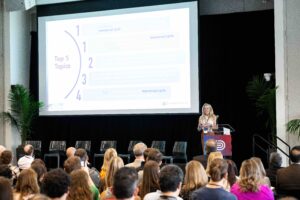2023 Symposium | Session, Female Athlete II
Session II: Female Athlete Performance
Half the world’s population is female, and more women are participating in sports than at any time in history; however, exercise and sports science research is still conducted predominantly in male populations.
As Dr. Silvia Blemker, an Alliance Agility Project Awardee, noted during her presentation, most “models of movement have been based on predominantly male datasets” – that represent the anatomy of a 5′ 10” man. What’s one example of the difference between men and women? The psoas, a major hip flexor muscle, tends to be larger in males than females even after accounting for height and mass, while soleus muscles are bigger in females than males. What are the implications of such differences? Dr. Blemker’s lab aims to help researchers answer this question through large-scale data collection and modeling.
Other Presentations During This Session
- Dr. Emily Kraus’ insight into the top five topics that interest female athletes, one of which is how the menstrual cycle can impact training and performance. Dr. Kraus leads the Female Athlete Program at Stanford University.
- Dr. NiCole Keith on how sexism, racism, ageism, and other -isms can impact female athletic activity and performance. Dr. Keith is a Science Advisory Council Member for the Wu Tsai Human Performance Alliance.
- Dr. Kathryn Ackerman on Relative Energy Deficiency in Sport (RED-S), which impacts performance and multiple physiological systems. The prevalence of RED-S in girls and women is somewhere between 23 and 79.5%, depending on population and measurement method. “That is quite the span, so we need to figure out how to study this better,” says Dr. Ackerman, who also highlights updates to the RED-S clinical assessment tool to monitor athletes. Dr. Ackerman is the Director of the Alliance’s Female Athlete Program.








Get Engaged
Join our mailing list to receive the latest information and updates on the Wu Tsai Human Performance Alliance.
